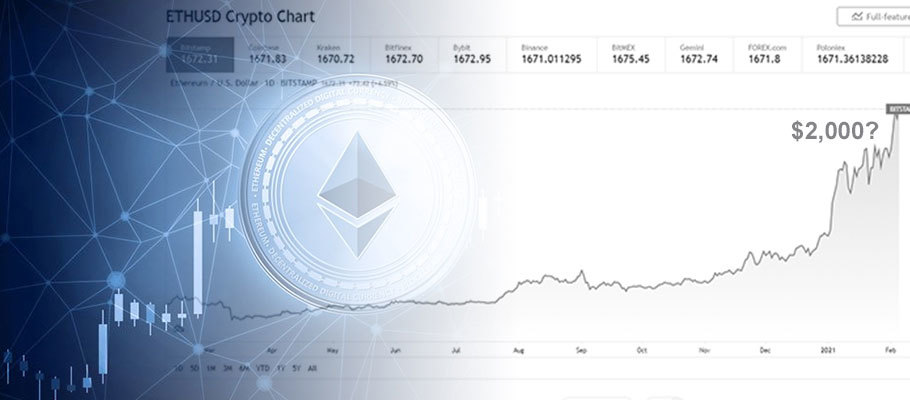
Published: February 5th, 2021
Ethereum (ETH), the world’s second-biggest crypto by market cap, reached a record-breaking high of USD 1,439 this week, the first time the digital asset has crossed the USD 1,400 threshold since January 2018.
That puts Ethereum’s gains for the year-to-date at above 65 per cent, a 6-times multiple over cryptocurrency leader Bitcoin and beating both Chainlink (LINK) and Polkadot (DOT) for the fastest-growing title. Even with the short-term correction experienced in January, ETH remains one of the strongest performers on the top 10 digital asset league table.
On fundamentals alone, there weren’t any apparent triggers driving Ethereum’s rise over the last few weeks. ETH had been hovering around the critical resistance level for more than a fortnight after climbing to USD 1,350 in early January. One likely catalyst is the exponential growth seen in decentralised finance (DeFi) this year. The DeFi market now holds more than USD 24 billion in crypto assets across its protocols. That will have contributed to the bullish momentum behind Ethereum, but it’s not the whole story.
Today, ETH finds itself approaching uncharted territory, with crypto watchers now anticipating the number-two cryptocurrency passing the next major milestone, the psychologically important USD 2,000 price point. If it hits that level, ETC will have seen a gain in the order of 50 per cent higher than its price this week.
Analysts and pundits believe three major events on the horizon in 2021 will help make a 2K ETH achievable.
The Chicago Mercantile Exchange (CME) announced in December that it plans to launch Ethereum futures this month. Regulatory approval still needs to be granted by America’s Commodity Futures Trading Commission (CFTC), but this is expected to be granted imminently.
Derivatives are trades that take the form of a contract, enabling investors to bet on the future price of an underlying asset (typically a commodity like oil, wheat, iron ore, etc.), without having to actually own it. The CME is the world’s largest derivatives platform, so getting the nod of approval from a stalwart of traditional finance marks an important milestone in the broader acceptance of the merits of cryptocurrency generally, and ETH specifically.
Ethereum is in the midst of moving its underlying blockchain from a Proof-of-Work to a Proof-of-Stake consensus mechanism. The idea behind the change is to make ETH faster, more scalable, and more efficient as a platform. The new ‘Ethereum 2.0’ moves forward in four phases, each setting the technical framework for the next until the full transition is finished.
Ethereum’s ‘Phase 0’ went live in December and included implementing what Ethereum calls the Beacon Chain. It’s a new software layer for the blockchain capable of coordinating activity across the various new Ethereum shard chains.
Next up in Ethereum’s development pipeline is ‘Phase 1,’ which will include the launch of 63 shard chains. Once in place, all transaction activity across the Ethereum network will be divided dynamically and processed by the separate blockchains to maximise efficiency and stop processing bottlenecks.
The new system architecture means transactions won’t have to be validated by the full network, a single shard chain can handle it. That promises to bring down the time required to confirm transactions dramatically. The overall network will gain capacity and be able to work with much bigger transaction volumes without falling victim to congestion, currently a big issue and source of complaints.
Ethereum isn’t just a cryptocurrency, it’s also a platform for blockchain application development. When an Ethereum-based decentralised application (dapps) takes an action, the Ethereum blockchain handles it as a transaction. Transactions have a fee attached to them, as it’s the only sure way to incentivise ETH miners to validate them.
At the moment, Ethereum transaction fees are set by an auction-style system where users who attach the highest fees to their transactions are more likely to attract miners' attention. This marketised approach makes for unpredictable and sometimes eye-watering fees during periods of heavy transaction activity. Ethereum has a reputation for experiencing congestion any time there’s a spike in trading activity. If Ethereum’s price goes sharply up or down, and crypto traders try and execute a trade en masse to take advantage, Ethereum can experience slowdowns.
Ethereum’s head honchos are well aware of the issue. Last year, co-founder Vitalik Buterin put forward EIP 1559, an Ethereum Improvement Proposal designed to improve the way ether transaction fees are presented to users. Buterin and a team of developers have suggested scrapping the current auction system favouring a base cost called the BASEFEE, which is determined by an algorithm.
Implementing BASEFEE would mean miners receive a uniform fee for processing all Ethereum-based services or transactions, regardless of rises and falls in transaction volume. The current raft of fee discrepancies that occur for ERC-20 compatible protocols and exchanges would be largely eliminated. Buterin’s proposal does come with an option for users to give miners a tip to make their transactions get processed more quickly.
The bit of EIP 1559 likely to have the biggest impact on Ethereum’s future price is the launch of Ethereum ‘burning’, which would enable users to eliminate tokens from existence entirely. This would reduce the circulating supply of Ethereum, and by the laws of supply and demand, push its price up. Buterin and colleagues plan to burn the BASEFEE as well so that most of the Ethereum used to process transactions is destroyed, rather than inflating the overall supply.
Analysts believe this could encourage Ethereum deflation, and help push up its price over time. Buterin’s EIP is expected to go live by early March 2021.